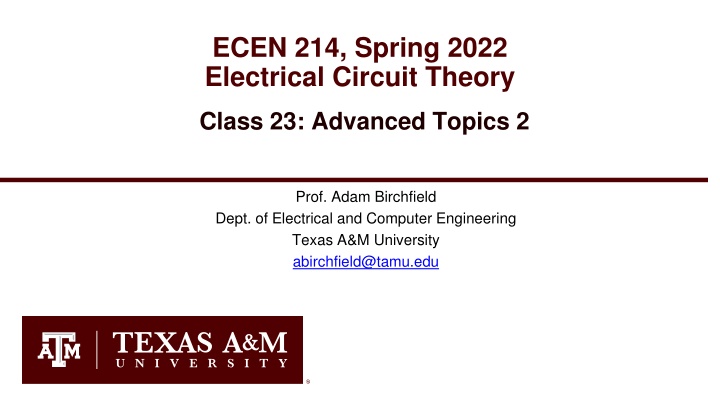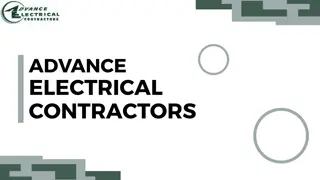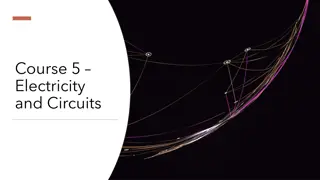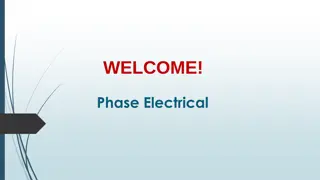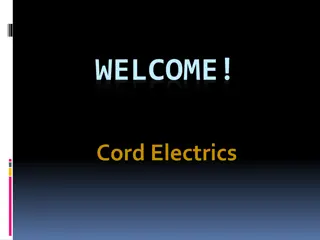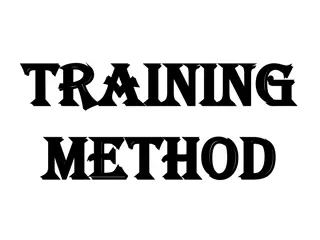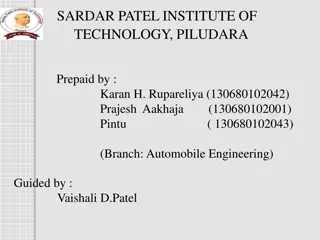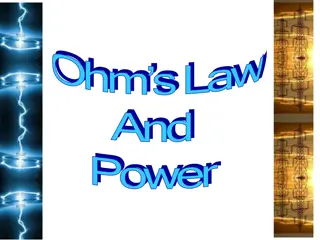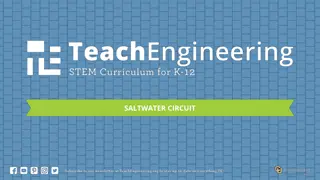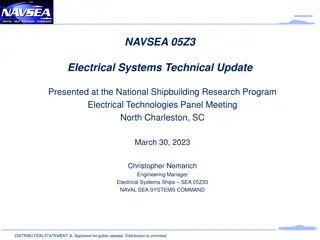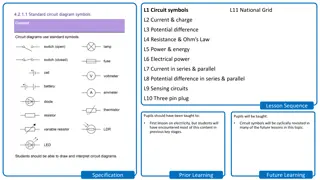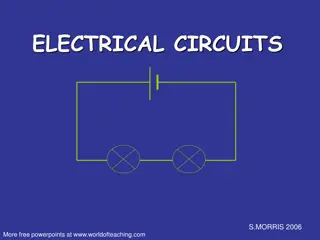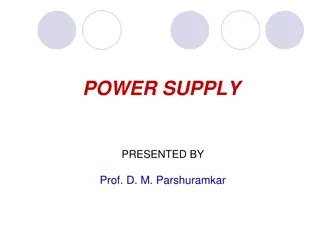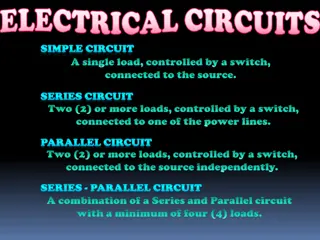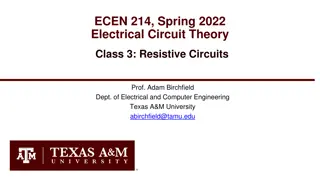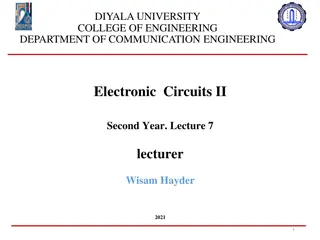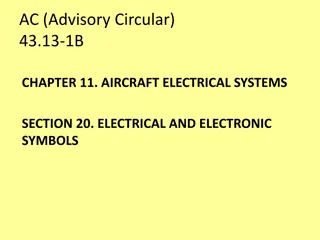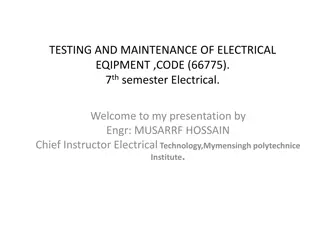Electrical Circuit Theory: Advanced Topics and Applications
Dive into the world of electrical circuit theory with a focus on advanced topics like writing and solving circuit equations, AC circuits, non-linear devices, transformers, and more. Explore the history of computer simulation in electric circuits and discover the pathways for further study and career opportunities in the field.
Uploaded on Feb 21, 2025 | 2 Views
Download Presentation

Please find below an Image/Link to download the presentation.
The content on the website is provided AS IS for your information and personal use only. It may not be sold, licensed, or shared on other websites without obtaining consent from the author.If you encounter any issues during the download, it is possible that the publisher has removed the file from their server.
You are allowed to download the files provided on this website for personal or commercial use, subject to the condition that they are used lawfully. All files are the property of their respective owners.
The content on the website is provided AS IS for your information and personal use only. It may not be sold, licensed, or shared on other websites without obtaining consent from the author.
E N D
Presentation Transcript
ECEN 214, Spring 2022 Electrical Circuit Theory Class 23: Advanced Topics 2 Prof. Adam Birchfield Dept. of Electrical and Computer Engineering Texas A&M University abirchfield@tamu.edu
2 One-Page Course Outline 2. Writing and solving first-order RL and RC circuit differential equations 3. Writing and solving second-order RLC circuit differential equations Unit 3. Steady-State AC Circuits 1. Phasors for AC voltage and current, complex algebra applied to AC circuits 2. Impedance for R, L, and C in AC circuits 3. AC Power: Complex power, real power, reactive power, power factor 4. AC Thevenin equivalents and maximum power transfer Unit 4. Advanced Topics 1. Non-linear devices 2. Circuit software 3. Three-phase 4. Transformers Unit 1. Steady-State DC Circuits 1. Voltage, current, resistance, Ohm s Law, KVL, KCL 2. Power, energy, independent sources, dependent sources 3. Open, short, parallel, series, voltage dividers, current dividers 4. Wye-delta transformation 5. Node-voltage circuit analysis method 6. Mesh-current circuit analysis method 7. Thevenin and Norton equivalents 8. Superposition, source transformations 9. Maximum power transfer 10. Ideal Op-Amp equations, linear and saturation regions Unit 2. Transient DC Circuits 1. Capacitor and inductor equations, steady-state behavior, transient behavior
3 Where You Go From Here Two more classes with advanced topics and review (conceptually may be on final) Wed 27 April Advanced topics 3: Three-phase AC power systems Mon 2 May Advanced topics 4: Ideal Transformers Final Exam Friday 6 May at 3:30pm The door to the rest of your major is now open: 325 Electronics 314 Signals Electives (21 hours) 214 Circuits 350 Comp. Arch. 322 E-mag 460 Power Systems Elective Birchfield Spring 2023 403/404 Capstone 248 Digital 340 Power 303 Random 370 Materials (Required) What s next? Internships, industry job opportunities, entrepreneurship Undergraduate research, graduate school for Masters or PhD
4 Brief History of Computer Simulation of Electric Circuits Initial development of ECAP program at IBM in mid-1960s SPICE developed at UC-Berkeley in early 1970s SPICE stands for Simulation Program with Integrated Circuit Analysis Improved version SPICE2 is in the public domain and has become industry standard 1984, MicroSim introduced Pspice, similar to SPICE for personal computers instead of mainframe, for industry and educational use Many additional version have been developed since, including developing a circuit by drawing the elements onto a graphical user interface (GUI) LTSpice was introduced in 1999 and is a standard freeware program for circuit simulation Source: Muhammad H. Rashid and Hasan M. Rashid, SPICE for Power Electronics and Electric Power, Taylor & Francis Group 2012.
5 How Can We Get a Computer to Solve this Circuit? 15 5 12 + _ 4 ? 3 ? + _ 22 ? 6 ? 8
6 End-of-Semester Feedback First, fill out the official university course assessment online at tamu.aefis.net Next, fill out the internal feedback survey for this class (same as the one we did in February) End-of-semester student survey is used by instructors, TAs, ECEN department, College of Engineering, and the university for improving this course We greatly value your feedback! There is no grade associated with any of the student surveys, and they are anonymous
7 Netlists First, we have to describe the circuit in a way the computer can understand (systematically) Use the Node-Voltage method notation: choose a reference node, number the other nodes. Devices now are listed by what they are connected to. This is known as a netlist 1 15 5 2 3 4 5 12 + _ 4 ? 3 ? + _ 22 ? 6 ? 8 Node 1 Node 2 Device Type Parameter(s) 1 2 Resistor 5 1 3 Resistor 15 3 4 Resistor 12 0 2 Current source 6 A 2 5 Voltage source 3 V 5 3 Current source 4 A 5 0 Resistor 8 0 4 Voltage source 22 V
8 Matrix Solution Resistors A matrix is created know as the conductance matrix (G matrix), which will represent all the equations of the circuit. KVL is already satisfied because of the way the node-voltage method is formulated We need to make sure we satisfy KCL and the equation for each element Types of equations KCL for single node or supernode Voltage equation for voltage sources For example, the KCL for node 1 (which will go on row 1) is ??12+ Ir13= 0 1 ?12 ?13 See g and I values on the right ?? = ? ?14 ?24 ?34 ?44 ?54 ?11 ?21 ?31 ?41 ?51 ?12 ?22 ?32 ?42 ?52 ?13 ?23 ?33 ?43 ?53 ?15 ?25 ?35 ?45 ?55 ?1 ?2 ?3 ?4 ?5 ?1 ?2 ?3 ?4 ?5 = 1 1 ?11= + ?12 ?13 1 ?12 1 ?13 ?12= ?13= ?14= ?15= ?1= 0 1 ?1 ?2 + ?1 ?3 = 0 For resistors, add the conductance (1/R) to the diagonal elements and subtract from the off-diagonal elements
9 Matrix Solution Current Sources For current sources, we just need to add the currents into the KCL equations For example, node 3 KCL ??13+ ??34+ ?35= 0 1 ?13 ?34 1 ?13 1 ?13;?34= ?32= ?35= 0 ?3= 4 The 4 A current source will be added to the node 3 KCL equation and subtracted from the node 5 one ?? = ? ?14 ?24 ?34 ?44 ?54 ?11 ?21 ?31 ?41 ?51 ?12 ?22 ?32 ?42 ?52 ?13 ?23 ?33 ?43 ?53 ?15 ?25 ?35 ?45 ?55 ?1 ?2 ?3 ?4 ?5 ?1 ?2 ?3 ?4 ?5 = 1 ?3 ?1 + ?3 ?4 = 4 1 ?33= + 1 ?34 15 5 2 1 3 4 ?31= ?34 5 12 + _ 4 ? 3 ? + _ 22 ? 6 ? 8
10 Matrix Solution Voltage Sources Voltage sources are more complicated because we can t use the KCL equations Need to create a supernode For the 22 V source, just add one equation instead of KCL for bus 4 ?44= 1;?41= ?42= ?43= ?45= 0;I4= 22 For the 3 V source, add an equation for voltage to replace node 2 KCL ?25= 1;?22= 1;?21= ?23= ?24= 0;?2= 3 Now since we have a supernode, we make a KCL equation on row 5 that adds the currents for the supernode 1 ?12 ?5= 6? 4? ?? = ? ?14 ?24 ?34 ?44 ?54 ?11 ?21 ?31 ?41 ?51 ?12 ?22 ?32 ?42 ?52 ?13 ?23 ?33 ?43 ?53 ?15 ?25 ?35 ?45 ?55 ?1 ?2 ?3 ?4 ?5 ?1 ?2 ?3 ?4 ?5 = 1 15 5 2 3 4 5 12 + _ 4 ? 3 ? + _ 22 ? 6 ? 8 1 1 ?51= ;?52= ?12;?53= ?54= 0;?55= ?50
11 Matrix Solution Final Matrix ?? = ? 1 1 5+ 1 15 1 1 15 5 2 3 0 0 4 5 15 0 ?1 ?2 ?3 ?4 ?5 0 3 4 5 12 + _ 0 1 0 1 4 ? 3 ? 1 1 15+ 1 12 1 + _ 22 ? = 0 0 6 ? 8 15 0 1 12 1 22 0 1 5 0 0 1 8 6 4 0 0 5 Solve for final voltages: ?1 ?2 ?3 ?4 ?5 0.267 0 0.067 0 0.2 0.2 1 0 0 0.2 0.067 0 0.15 0 0 0 0 0 1 0 0 0 3 4 22 2 ?1 ?2 ?3 ?4 ?5 31.53 24.4 52.9 22 27.4 = 0.083 1 0 = 0.125 Once we have these we can get anything else we want
12 Types of Analysis in SPICE Programs DC operating point what we just did, solve the DC circuit in steady state DC sweep change a parameter over a range of values and get the solution for each one (for example, what if we increase or decrease the current source from 4 A) Small-signal transfer function like a Thevenin equivalent Transient analysis how the circuit behaves in response to time-varying devices, including switches Frequency analysis results of the transient simulation at DC and after a Fourier transform AC circuit response at a single frequency or a range of frequencies
